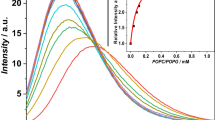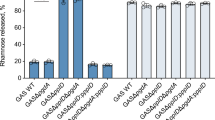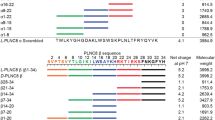Abstract
Sublancin is shown to be an S-linked glycopeptide containing a glucose attached to a cysteine residue, establishing a new post-translational modification. The activity of the S-glycosyl transferase was reconstituted in vitro, and the enzyme is shown to have relaxed substrate specificity, allowing the preparation of analogs of sublancin. Glycosylation is essential for its antimicrobial activity.
This is a preview of subscription content, access via your institution
Access options
Subscribe to this journal
Receive 12 print issues and online access
$259.00 per year
only $21.58 per issue
Buy this article
- Purchase on Springer Link
- Instant access to full article PDF
Prices may be subject to local taxes which are calculated during checkout


Similar content being viewed by others
References
Oman, T.J. & van der Donk, W.A. Nat. Chem. Biol. 6, 9–18 (2010).
Kunst, F. et al. Nature 390, 249–256 (1997).
Hemphill, H.E., Gage, I., Zahler, S.A. & Korman, R.Z. Can. J. Microbiol. 26, 1328–1333 (1980).
Paik, S.H., Chakicherla, A. & Hansen, J.N. J. Biol. Chem. 273, 23134–23142 (1998).
Willey, J.M. & van der Donk, W.A. Annu. Rev. Microbiol. 61, 477–501 (2007).
Siezen, R.J., Kuipers, O.P. & de Vos, W.M. Antonie Van Leeuwenhoek 69, 171–184 (1996).
Kodani, S. et al. Proc. Natl. Acad. Sci. USA 101, 11448–11453 (2004).
Goto, Y. et al. PLoS Biol. 8, e1000339 (2010).
McIntosh, J.A., Donia, M.S. & Schmidt, E.W. Nat. Prod. Rep. 26, 537–559 (2009).
Lote, C.J. & Weiss, J.B. FEBS Lett. 16, 81–85 (1971).
Dorenbos, R. et al. J. Biol. Chem. 277, 16682–16688 (2002).
Dubois, J.Y. et al. Antimicrob. Agents Chemother. 53, 651–661 (2009).
Lairson, L.L., Henrissat, B., Davies, G.J. & Withers, S.G. Annu. Rev. Biochem. 77, 521–555 (2008).
Walsh, C.T. Post-translational Modification of Proteins: Expanding Nature's Inventory (Roberts & Company, Greenwood Village, Colorado, 2005).
Baran, E. & Drabarek, S. Pol. J. Chem. 52, 941–946 (1978).
Jahn, M., Marles, J., Warren, R.A. & Withers, S.G. Angew. Chem. Int. Edn Engl. 42, 352–354 (2003).
Driguez, H. ChemBioChem 2, 311–318 (2001).
Cohen, S.B. & Halcomb, R.L. J. Am. Chem. Soc. 124, 2534–2543 (2002).
Galonić, D.P., van der Donk, W.A. & Gin, D.Y. Chem.–Eur. J. 24, 5997–6006 (2003).
Galonić, D.P., van der Donk, W.A. & Gin, D.Y. J. Am. Chem. Soc. 126, 12712–12713 (2004).
Galonić, D.P., Ide, N.D., van der Donk, W.A. & Gin, D.Y. J. Am. Chem. Soc. 127, 7359–7369 (2005).
Hili, R., Rai, V. & Yudin, A.K. J. Am. Chem. Soc. 132, 2889–2891 (2010).
Blanchard, S. & Thorson, J.S. Curr. Opin. Chem. Biol. 10, 263–271 (2006).
Thibodeaux, C.J., Melancon, C.E. & Liu, H.W. Nature 446, 1008–1016 (2007).
Fuller, E. et al. FEBS J. 272, 1727–1738 (2005).
Acknowledgements
This work was supported by the US National Institutes of Health (GM58822 to W.A.v.d.D.) and a US National Institutes of Health Cellular and Molecular Biology Training Grant (T32 GM007283 to T.J.O.). X.N.O. was supported by the EXROP summer research program of the Howard Hughes Medical Institute.
Author information
Authors and Affiliations
Contributions
T.J.O. performed mass spectrometric analyses and all biochemical assays shown, which were designed and analyzed by T.J.O. and W.A.v.d.D. J.M.B. performed NMR analysis. H.W. prepared and performed biochemical assays of the SunA mutant peptides. X.N.O. assisted with purification of sublancin and mass spectrometric analyses. T.J.O. and W.A.v.d.D. wrote the manuscript.
Corresponding author
Ethics declarations
Competing interests
The authors declare no competing financial interests.
Supplementary information
Supplementary Text and Figures
Supplementary Methods, Supplementary Figures 1–21 and Supplementary Table 1 (PDF 8959 kb)
Rights and permissions
About this article
Cite this article
Oman, T., Boettcher, J., Wang, H. et al. Sublancin is not a lantibiotic but an S-linked glycopeptide. Nat Chem Biol 7, 78–80 (2011). https://doi.org/10.1038/nchembio.509
Received:
Accepted:
Published:
Issue Date:
DOI: https://doi.org/10.1038/nchembio.509
This article is cited by
-
Protein cysteine S-glycosylation: oxidative hydrolysis of protein S-glycosidic bonds in aqueous alkaline environments
Amino Acids (2023)
-
Bacteriocins from lactic acid bacteria and their potential clinical applications
Applied Biochemistry and Biotechnology (2022)
-
Characterization and Quantitative Determination of a Diverse Group of Bacillus subtilis subsp. subtilis NCIB 3610 Antibacterial Peptides
Probiotics and Antimicrobial Proteins (2021)
-
Characterization, Cytotoxic Analysis and Action Mechanism of Antilisterial Bacteriocin Produced by Lactobacillus plantarum Isolated from Cheddar Cheese
International Journal of Peptide Research and Therapeutics (2020)
-
Advances on the in vivo and in vitro glycosylations of flavonoids
Applied Microbiology and Biotechnology (2020)



